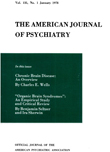Neuroleptic-induced supersensitivity psychosis: clinical and pharmacologic characteristics
Abstract
Tardive dyskinesia is thought to result from neostriatal dopaminergic receptor supersensitivity induced by chronic treatment with neuroleptics. The authors suggest that dopaminergic supersensitivity also occurs in the mesolimbic region after chronic neuroleptic exposure, resulting in the development of a supersensitivity psychosis. Neuroleptic-induced supersensitivity psychosis is illustrated by data from 10 patients that demonstrate the syndrome's clinical and pharmacologic characteristics. An implication of neuroleptic-induced mesolimbic supersensitivity is that the tenaency toward psychotic relapse in such patients is determined by more than just the normal course of the illness.
Access content
To read the fulltext, please use one of the options below to sign in or purchase access.- Personal login
- Institutional Login
- Sign in via OpenAthens
- Register for access
-
Please login/register if you wish to pair your device and check access availability.
Not a subscriber?
PsychiatryOnline subscription options offer access to the DSM-5 library, books, journals, CME, and patient resources. This all-in-one virtual library provides psychiatrists and mental health professionals with key resources for diagnosis, treatment, research, and professional development.
Need more help? PsychiatryOnline Customer Service may be reached by emailing [email protected] or by calling 800-368-5777 (in the U.S.) or 703-907-7322 (outside the U.S.).



